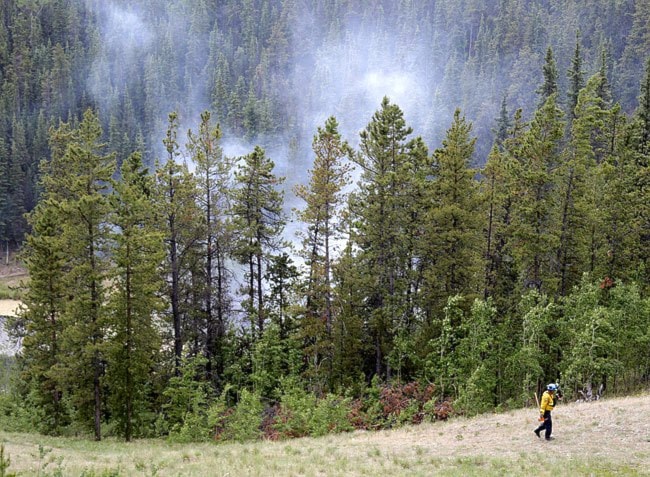When it comes to the devastation of Fort McMurray, the positives are few and far between. But one is that the national conversation about fire safety is heating up.
Mike Flannigan, the University of Alberta’s director of Western Partnership for Wildland Fire Science, has been warning that many communities across Canada “face far greater risk from wildfire than Fort McMurray.”
Why? Canadian communities are often enveloped by fuel, like combustible conifer forests, while the frequency and severity of catastrophic fires is predicted to rise with climate change.
Whitehorse fits that description. It is surrounded by aging pine and spruce forests, while Yukon is warming twice as fast as southern Canada, according to the Yukon College’s climate report.
To manage these hazards, Flannigan suggests a two-kilometre buffer zone between these forests and development. Such buffers don’t exist for many of Whitehorse’s neighbourhoods, which often back directly on to forest.
That has Myles Thorp, an experienced forest professional and head of the Yukon Wood Products Association, concerned. “This forest is ready to burn, and it’s ready to burn on a very large scale,” he said. “Nobody is saying this summer, or next summer or 20 summers from now, but within that the chances are increasing,” he said.
FireSmart is the national program that seeks to address this, which smaller jurisdictions implement on their own accord. The program recommends wildfire “fuel management” through thinning - taking away deadfall and shrubs, removing trees, planting less flammable species like deciduous aspen and birch, and more aggressive measures like digging ditches as barriers or prescribed burning.
“What we do is address the hazards. If a fire does get started, there is less of a chance for it to grow,” said Colin Urquhart, the Yukon’s FireSmart coordinator.
Since 1998, Yukon has been implementing some of these measures, but not all. Typical treatment is thinning, or pruning, and ridding of surface fuels, Urquhart said. They’ve been working in neighbourhood greenbelts, breaking up coniferous forest stretches like along Maclean Lake Road and planting deciduous species.
But for Thorp, this still isn’t enough. “If and when this is coming, we need to get serious about doing fairly aggressive management,” he said. “What we’ve done is enough when the hazard is low, but when you get into bigger situations like Fort McMurray we need lots more.”
Thorp is talking about “fire guarding” through the removal of blocks of forest to create more effective buffer zones. As a homeowner in Copper Ridge, he wants to see 100 metres of trees removed on the edge of the neighbourhood, noting that the Fort McMurray fire penetrated subdivisions up to four blocks.
“I know I will lose my house if the right fire comes to this area,” Thorp said.
Urquhart said there are certainly still hazards that FireSmart is continuing to address. “Whitehorse as a whole is surrounded by fuel from trees and forests, and fire burns quicker going up hill and quicker with winds pushing it,” he said.
The Department of Energy, Mines and Resources’ forest management branch has been working with the Carcross-Tagish, Kwanlin Dun and Ta’an Kwach’an First Nations to create land use plans for future harvesting in the region. Those plans will likely also involve Yukon Wildland Fire Management.
The Yukon Wood Products Association would like to see some assurance that as FireSmarting becomes more robust, the amount of wood fibre coming off the land base doesn’t overwhelm the fledgling community forest industry. Currently, around half of all FireSmart wood collected on territorial land is put up for grabs to the public for free.
“We would like to see it developed so that the community fire cutters would have the opportunity to conduct that cutting and own the wood themselves, to be able to market it for fuel and maybe even biomass boiler systems,” Thorp said. He said their concerns have so far been well received, but forest management just doesn’t have a big picture as to how they would organize it yet.
Meanwhile, the City of Whitehorse bases its forest forest management efforts on a report produced in 2002 that outlines hazard areas. The report itself qualifies that it is not a comprehensive fire management plan, recommending one in future. Fire Chief Kevin Lyslo said they are currently evaluating whether it needs to be re-commissioned.
“There is a lot of gap between the hazard and the amount of planning that has to be done,” Thorp said.
The Canadian Council of Forests just released its re-vamped 10 year strategy wildland fire management, urging all levels of government and actions to accelerate in addressing “significant challenges ahead.”
“I would say we are lucky. We work nationally with a lot of partners,” Urquhart said.
Contact Lauren Kaljur at
lauren.kaljur@yukon-news.com
